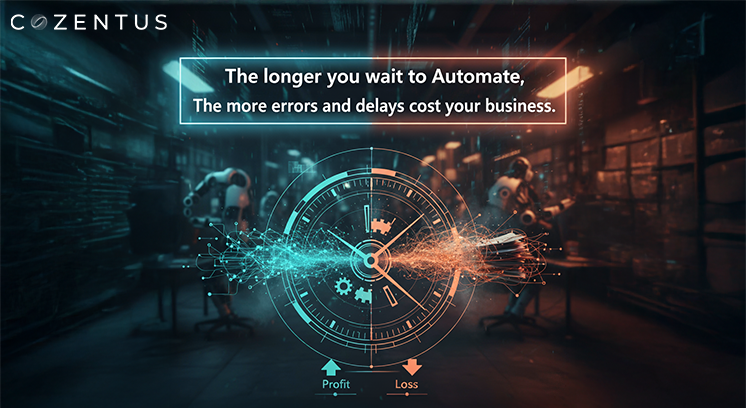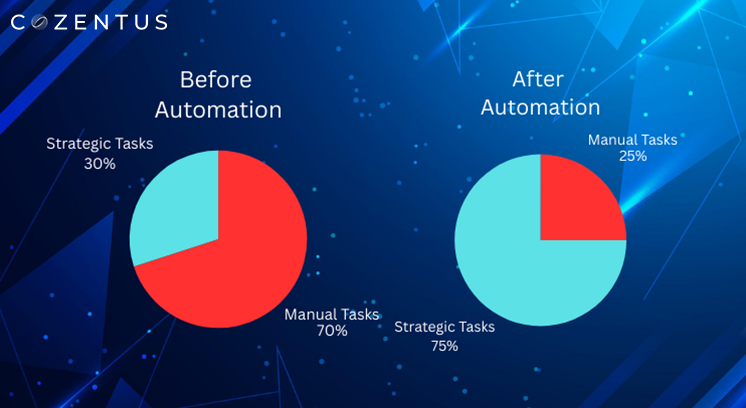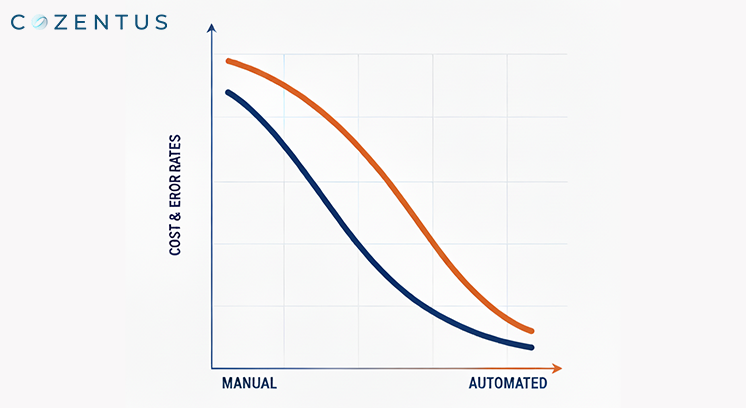The Everyday Grind That Drains the Team
If you walk into most operations teams today, you’ll see people buried in spreadsheets, chasing status updates, manually copying data between systems, or sending late-night emails to fix an error that should never have happened in the first place.
It isn’t because these teams lack skill or dedication. It’s because too much of their work is repetitive, rule-based, and time-consuming. And while this chaos eats up hours every single day, it adds little to no real business value.
Now here’s the good news: this kind of chaos doesn’t take months or years to fix. We’ve seen entire workflows transformed in as little as two weeks. With automation, intelligent workflows, and the right technology-first mindset.
At Cozentus, we believe operations should not feel like constant problem-solving. They should offer growth, customer trust, and efficiency. And that’s exactly what automation and RPA (Robotic Process Automation) do.
Ley’s dive deeper into this.

Why Two Weeks Can Change Everything
A “two-week fix” might sound bold. But in today’s digital-first world, it’s possible to make quick, tangible improvements without rewriting your entire business model.
That’s because RPA and automation don’t always require large, complex system overhauls. Instead, they sit on top of your existing tools (like the ERP, TMS, WMS, or finance systems) and automate the manual, repetitive steps that slow teams down.
As per research by McKinsey, automation can cut cost-heavy, repetitive tasks by 60 – 70%. For an operations team that spends four hours daily on manual updates, that’s an immediate time savings of two to three hours per person, every day. Multiply that across dozens or hundreds of employees, and the impact is enormous.
The real value, though, isn’t just saved hours. It’s how those hours get reinvested. You can dedicate those hours to solving problems, improving customer experience, and driving growth.

The Pain Points We Hear Every Day
When we speak to senior executives across industries, especially in supply chain logistics, the pain points are strikingly similar:
- Too Many Manual Updates: Teams spend more time typing than thinking.
- Data Scattered Across Systems: ERP, spreadsheets, emails, and platforms don’t talk to each other.
- Errors and Rework: A small mistake in data entry can result in customer dissatisfaction or financial loss.
- Reactive Problem-Solving: Teams chase issues after they occur, instead of preventing them.
- High Cost of Inefficiency: Each manual task adds hidden costs, such as lost time, reduced morale, and higher labor dependency.
For logistics leaders, these challenges are even bigger. Missed shipment updates, delays in customs paperwork, or mismatched invoices don’t just cause frustration; they directly hit customer trust and bottom-line results.
This is why automation isn’t just “nice to have.” It’s becoming a necessity.
Here’s the 2-Week Fix
So, what actually happens in those first two weeks? Here’s how Cozentus helps organizations achieve fast wins:
1. Identify Quick-Win Processes
We start by looking for processes that are:
- High in volume but low in complexity.
- Rule-based, repetitive, and predictable.
- Currently being done manually, often by copying and pasting between systems.
This step is all about focus. Instead of trying to “automate everything,” we target the 2 - 3 areas that are creating the most daily frustration and wasting crucial hours.
In logistics, that might mean automating shipment status updates, validating invoices against contracts, or reconciling order data between ERP and TMS. In finance, it might be matching payments against invoices. In HR, it could be onboarding paperwork. Quick wins build momentum and show immediate results.
2. Build and Deploy Simple Bots
Once the opportunities are identified, we design small, agile AI bots within days. These aren’t huge, complex projects - they’re lightweight, targeted automations that make an immediate impact.
Think of them as digital teammates who:
- Never sleep or take breaks.
- Work with perfect accuracy every time.
- Scale up instantly when volume spikes.
The bots can log into systems just like a human user would, extract data, perform validations, and update records across platforms. And because they integrate with your existing systems, there’s no need to replace your current IT stack.
3. Test, Validate, and Improve
We know trust is critical. That’s why we run the bots in parallel with your team’s workflow during the testing phase. This gives employees the chance to see the bots in action, compare results, and build confidence in their accuracy.
This stage is also where small refinements happen. Maybe a business rule needs adjusting, or a particular data source needs to be included. Because the bots are modular and agile, changes are quick and simple.
The goal is clear: ensure the bot performs as reliably as your best-trained employee.
4. Go Live and Free Up Hours
By the end of two weeks, these bots will be live in production. Teams immediately feel the difference.
- Daily workloads shrink
- Errors fall
- Response times improve
What used to take hours can now be done in minutes (or not done at all), because the bot has already handled it.
For leaders, this means a leaner cost base and a more scalable operations model. For teams, it means the chance to focus on problem-solving, innovation, and customer value instead of drowning in repetitive tasks.

The Business Impact: Beyond Just Time Savings
Time savings alone are a big achievement. But for executives, the real value lies in what automation offers:
- Higher Accuracy: Bots don’t mistype numbers or forget steps. That means cleaner data and fewer disputes.
- Scalability: Operations can handle growth without adding more people.
- Happier Teams: Employees spend less time on dull tasks and more on work that matters.
- Better Customer Experience: Faster updates, fewer errors, and proactive service win trust.
- Faster ROI: Many automation projects pay for themselves within months (sometimes weeks).
For logistics organizations, the benefits are even better: proactive risk monitoring, clean freight audit data, and smoother shipment visibility - all powered by automation.
A Real Example: From Chaos to Control
Imagine a mid-size logistics provider struggling with invoice processing. Every day, dozens of employees were manually matching carrier invoices against shipment data, hunting for errors, and preparing dispute cases. It consumed nearly half of their operations team’s time.
With a 2-week RPA deployment:
- A bot was built to pull invoices automatically.
- Each invoice was matched against shipment events and agreed-upon rates.
- Any mismatches were flagged instantly, with a ready-to-go dispute file.
The result? Hours of manual work vanished. Error rates dropped. Disputes were resolved faster. The finance team was freed to focus on strategy and vendor management instead of doing paperwork.
That’s what we mean by turning chaos into control in just two weeks.
Read the Full Case Study Here: Automated Invoice Integration (RPA)
Why Cozentus?
Plenty of technology providers can sell automation. But at Cozentus, we bring an end-to-end services approach that aligns with your business strategy.
Here’s what sets us apart:
- Domain Expertise: From logistics to finance to enterprise IT, we know your industry challenges.
- Integrated Services: We combine automation with real-time visibility, risk monitoring, freight audit, testing, and analytics.
- Scalable Approach: Start with a two-week quick win, then scale across processes, business units, and regions.
- Partnership Mindset: We work with your teams, not over them—so adoption is faster and smoother.
The result is not just a bot running in the background, but a future-ready operations model that grows with your business.
Where Should You Start
If there’s one takeaway from this blog, it’s this: transformation doesn’t have to start with a massive IT project. You can start small, see results in weeks, and then expand.
Start by asking simple questions:
- Which tasks are repetitive and rule-based?
- Where do errors or delays occur most often?
- What processes frustrate my team daily?
The answers will point directly to automation opportunities. From there, it’s about finding the right partner who can deliver - not in years, but in weeks.
Bottomline: The Future of Operations Is Automated
We often hear leaders say, “We don’t have the time for automation right now.” The truth is, you don’t have the time “not to”.
Every day wasted on manual, repetitive tasks is time taken away from growth, strategy, and customer value. A two-week fix may sound too simple - but it’s real, it’s proven, and it’s helping businesses grow today.
At Cozentus, we’ve seen it first-hand how automation can replace chaos with clarity.
The only question is: are you ready to give your teams their time back?
If yes, here’s where you need to call.
Recent Post
Subscribe to our newsletter
Stay updated on latest trends and news in the supply chain and logistics industry
Join our mailing list for monthly updates
Download Whitepaper
Burnt out or Bottlenecked? How Custom Tech Is Quietly Powering the Next Wave of Logistics Ops
Download







